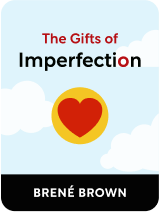

This article is an excerpt from the Shortform book guide to "The Gifts of Imperfection" by Brené Brown. Shortform has the world's best summaries and analyses of books you should be reading.
Like this article? Sign up for a free trial here .
How can practicing calm and stillness help you to fight anxiety? What are the major barriers to calm and stillness?
In her book The Gifts of Imperfection, Brené Brown advises readers to practice calm and stillness in order to fight anxiety. Her goal isn’t to eliminate anxiety—that’s nearly impossible—but to help you recognize it and work on ways to reduce its impact.
Here is Brené Brown’s advice on how to practice calm and stillness and what barriers you’ll need to overcome.
Practice Calm and Stillness to Fight Anxiety
Brené Brown’s eighth guidepost for Wholehearted living is fighting anxiety by practicing calm and stillness. Anxiety is becoming increasingly common in the modern world. As well as being generally distressing, it can impact your ability to live Wholeheartedly in several ways.
First, anxiety can manifest as self-doubt: for example, worrying about whether you’re really “good enough.” It’s hard to maintain your worthiness and live Wholeheartedly if you’re constantly panicking over the possibility that you’re not worthy after all.
Second, anxiety can negatively impact your courage, compassion, and shame resilience, among other factors necessary for Wholehearted living. When you’re overwhelmed by anxiety, it’s hard to focus on practices that will increase your feelings of self-worth.
According to Brown’s research, people who live Wholeheartedly aren’t necessarily free of anxiety. Instead, they maintain an awareness of their anxiety while simultaneously looking for ways to reduce its impact. A common method used to reduce the effects of anxiety is practicing stillness and calm.
Practicing Stillness
Practicing stillness means taking the time to be still and quiet. This might take the form of praying, meditating, or just having some reflective alone time.
A common misconception around stillness is that it’s about completely clearing your mind of all thoughts and emotions. You might find this idea daunting. Your brain is constantly swimming with thoughts, ideas, and feelings. Getting rid of all of that noise might feel impossible.
However, stillness isn’t about ridding your mind of all noise. It’s merely about quieting the noise a bit and clearing some space in your mind. You can use this “space” to get in touch with your deepest thoughts, emotions, hopes, and dreams; to contemplate your problems, remind yourself of your strengths, and maybe even challenge the roots of your anxiety. Even if you don’t feel capable of challenging your anxiety, you can use the “space” as a brief reprieve from it.
Practicing Calm
To practice calm you need to do two things. First, you need to put difficult situations into perspective. Second, you need to stop yourself from instantly reacting to your emotions.
Putting Things in Perspective
The first aspect of calmness is putting difficult situations into perspective. This means viewing the situation mindfully and rationally. When we get anxious, we tend to catastrophize. We tell ourselves that our current situation is a complete disaster and the worst thing to ever happen to us. Putting things in perspective involves challenging catastrophic thoughts by questioning their validity. Is the situation really a disaster? Will you even remember it happened in a week, a month, or a year? What will the situation’s actual impact be?
For example, imagine you email a colleague and spell their name wrong. A catastrophizing reaction to this would be “This person will think that I’m stupid for misspelling their name. If my boss finds out I did this, I’m going to get fired.” Meanwhile, a reaction that puts things into perspective would be “Yes, this wasn’t great, people make small mistakes like this all the time. I can apologize to the person the next time I see them, and that’ll be the end of it.”
Gaining perspective and refusing to catastrophize will help you to view your anxiety and its triggers in a balanced way. You’ll be more likely to remain calm.
Curbing Instant Emotional Reactions
The second aspect of practicing calmness is stopping yourself from instantly reacting to your emotions, particularly strong negative emotions such as anger or fear.
When you experience these strong feelings, you may rush to express them just to get them out of your head and stop them from affecting you as much. However, this desperation to express feelings may cause you to hastily react in a harmful way.
For example, if you’re in a situation that’s made you anxious, your visceral reaction might be to criticize the person who’s triggered the situation; to channel your anxiety in their direction. The results of this reaction will probably be overwhelmingly negative. For instance, you may damage your connection with the person you’ve criticized.
To stop yourself from instantly reacting to your emotions, you could:
- Count to ten before reacting. This gives your strong emotions time to cool down.
- Take ten deep breaths in and out: breathing exercises like this can promote calmness.
- Take the time to evaluate the possible effects of expressing your emotion. Consider whether expressing your feelings right now will really help matters.
(Shortform note: For more on learning how to control your emotional reactions, read our summary of Daniel Goleman’s Emotional Intelligence.)
Barriers to Stillness and Calm
Two barriers may affect your willingness to be still and calm.
The first barrier is the fear that practicing stillness will lead to repressed, uncomfortable thoughts coming to the forefront of your mind. You may be choosing to ignore thoughts about your fears, your flaws, and things that are making you unhappy. Keeping a constant background noise of thoughts in your mind helps to drown these uncomfortable thoughts out. However, when you use stillness to quieten the noise, the uncomfortable thoughts have nowhere to hide. You can’t ignore them any longer, which may seem like a terrifying prospect.
However, it’s important to remember that these fears, flaws, and sources of unhappiness will never be resolved if you refuse to confront them. Bringing them into the light will take courage at first, but it’s the first step in improving your life. For this reason, the possibility of confronting uncomfortable thoughts shouldn’t be an excuse not to practice stillness. Instead, it’s just another reason why it’s so important to do so.
The second barrier to practicing stillness and calm is the persistence of negative childhood memories of these concepts. When you were a child, the adults in your life may have ordered you to be still and calm when they were frustrated with you or wanted to exert control. This may have led you to strongly associate practicing stillness and calm with being in trouble and feeling shame. When, as an adult, you try to practice stillness and calm, the memories of these negative emotions might resurface. This may put you off trying to be still or calm.
You can overcome these negative associations by forcing yourself to practice stillness and calm. At first, doing so may feel uncomfortable. It may take courage to continue. However, the more you practice calm and stillness, the more you’ll reap their benefits, and the more your anxiety surrounding these ideas will reduce. You’ll replace your negative associations with positive ones.

———End of Preview———
Like what you just read? Read the rest of the world's best book summary and analysis of Brené Brown's "The Gifts of Imperfection" at Shortform .
Here's what you'll find in our full The Gifts of Imperfection summary :
- How to stop feeling like you're not "good enough"
- How shame affects your self-worth
- The 10 guideposts to living Wholeheartedly and cultivating worthiness






